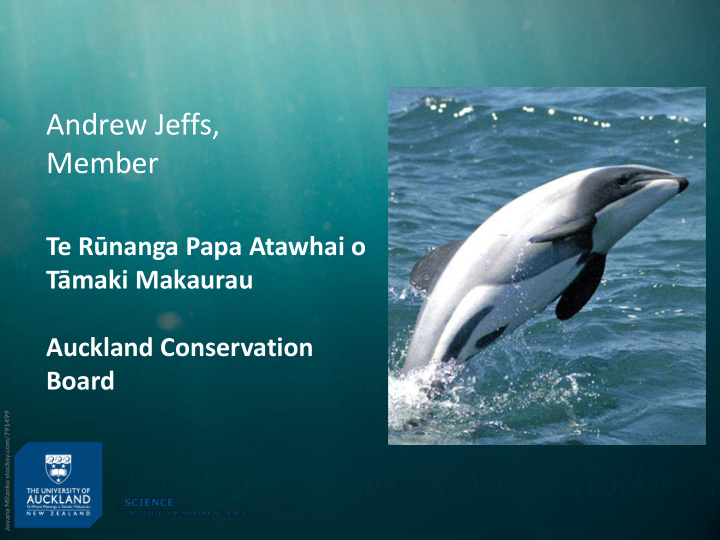



Andrew Jeffs, Member Te Rūnanga Papa Atawhai o Tāmaki Makaurau Auckland Conservation Board
Hauraki Gulf Globally significant marine mammal habitat
Whales & Dolphins • Highly social animals • Live in an acoustic world • Sound travels long distances underwater • Echolocate – underwater radar • Communicate – talk to one another • Navigate – finding each other • Environmental sound cues – dinner bells • Stun prey – stun gun
Human Underwater Sound Vessel impacts on whales & dolphins:- • Disturbance & avoidance • Stop or reduce feeding • Silenced or more frequent calling – “masking” • Health effects
Underwater Sound in the Gulf • Low background noise • Higher for inner Gulf • Vessel sound 35.2% Bean Rock LOUDNESS versus – 1.9% Horn Rock Inner Gulf Mid Gulf Outer Gulf Low - PITCH - High
Underwater Sound in the Gulf LOUDNESS Inner Gulf Mid Gulf Outer Gulf Low - PITCH - High Sound is additive
Underwater Sound in the Gulf Tugs towing barges LOUDNESS Inner Gulf Mid Gulf Outer Gulf Low - PITCH - High Sound is additive
2800 m 3600 m 990 m Estimated detection distance for dolphins for vessel of 178 dB re 1 µPa @ 1 m. Masking occurs at lower range
Bryde’s Whale • “Nationally Critical” species • NZ population ~250 whales • ~46 resident in the Gulf • 44 deaths in the Gulf since 1989 • 85% known deaths ship strike • Spends a lot of time on surface • “Sleeps” on the surface at night • Likely sensitive to low frequency sound
Bryde’s Whale
Other Species Bigeye- nocturnal schooling fish Crayfish post-larvae
Options Marine Mammal Acoustic Thresholds :NOAA - Fisheries West Coast Region Only widely circulated threshold values, but some conjecture Behavioral disruption for continuous noise (e.g., vibratory pile driving, drilling) - Recommends threshold of 120 dB rms Problem: based on bowhead whales responding to drilling operations in the Arctic Ocean. i.e., very different acoustic environment, and assumes the hearing in all species is the same, which we know it is not. Possible Conditions: DMC could put a sound output limit on vessel-tug combination.
Recommend
More recommend